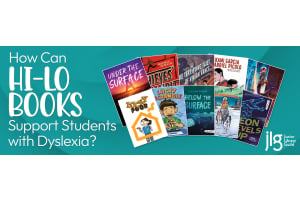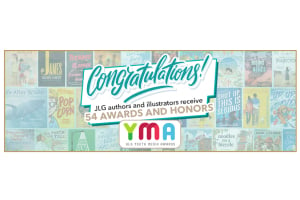9 Ways to Inspire Your Reluctant Readers


Now is the Perfect Time
It’s officially the start of a new year, that magical time between winter break and spring break when motivation is at its peak and everyone just seems to be in the flow of things.
For school librarians, this means right now is the perfect time to work with students who might need that extra push to get a book (or an e-reader) into their hands. While the energy is high, here are nine librarian-tested ways you can encourage and inspire your reluctant readers to incorporate reading into their daily lives.
After all, studies show just 6 more minutes of daily reading can bring below benchmark readers to at or above benchmark by the end of the year.
1. Hook them with hi-lo books
If your school library serves tweens and teens, then you know the last thing they want to be seen with is a “baby book,” which is why librarians often turn to Hi-Lo materials. A good high interest, low vocabulary book will keep struggling readers engaged.
So what should librarians look for in a good Hi-Lo book? For starters, a good Hi-Lo book will consistently keep the plot moving and provide the qualities of supportive formatting, like the appropriate placing of text and illustrations on the page. Other characteristics of good Hi-Lo materials include:
- Consistent reinforcement of challenging concepts and vocabulary
- Uncomplicated plot development
- Realistic characters that are clearly defined and distinguishable from one another
As this Reading Rockets blog suggests, adapted classic novels may not be the best route for reluctant readers, since these materials would still have more complex concepts and plots.
Need some good book recommendations for new Hi-Lo titles for your school library? You can easily explore JLG’s recommended collection of Hi-Lo books for middle and high schoolers (you’ll find these titles available with our book box delivery.)
2. Team up with teachers to identify reluctant readers
Do you know who your reluctant readers are? Teaming up with teachers to find out who needs extra support and why, is the first step in building a relationship with these students.
Aasking a few simple questions to find out which books to recommend based on their interests and hobbies may be all you need to get them to open up. To streamline the process, try a fun and simple beginning and end of year reading interest survey that helps you to identify their interests and reading habits.
3. Get Strategic with Displays
If you’re a parent of a reluctant reader (or you know one), then you’ve probably noticed that while a struggling reader may put up a fight to go to the library, they get excited when they’re at the bookstore. Librarians also most likely notice that reluctant readers perk up at the school book fair.
Consequently, many school librarians have begun implementing merchandising strategies with book displays in their libraries, which have an immediate and dramatic effect on boosting circulation. Some studies have shown increases in circulation of over 90%.
While most library budgets don’t allow for all the shiny new books you get at a book fair, librarians can use their skills to keep displays fresh and make their libraries appealing with strategic, attractive, and colorful book displays that grab reluctant readers and pull them in.
For an in-depth look at how to make your school library have the appeal of a bookstore, check out this guide.
4. Create a space in your library for peer recommendations
When you buy something online, how often do you make your final decision based on reviews?
Surveys have come out highlighting that one of the top reasons we buy books is because a friend or family member recommended it. Pew Research states that 64% of readers “ages 16 and older said they get book recommendations from family members, friends, or co-workers.”
The takeaway? School librarians can use social proof to their advantage and reel-in reluctant readers with book recommendations from fellow students. After all, if a book is deemed worthy by peers, there’s a good chance your reluctant readers will give it a shot as well.
One simple way to encourage students to leave peer-reviewed book recommendations at the circulation desk is to provide a suggestion jar with sticky notes. Once you have the recommendations, you can pull the books from the shelves and set up a display, or add them to your collection development wish list.
Librarians can also incentivize book reviews and recommendations with giveaways or 15 minutes of fame, featuring student selfies displayed alongside their recommended books. Online peer-reviews in your school’s virtual library can also be another way to involve students, especially those who may not attend school full-time.
Ultimately, peer-recommendations not only help reluctant readers, they can also help guide librarians towards future book selections and keep librarians up to date on current student trends. By doing this, librarians are fostering student voice, which gives students a greater sense of ownership and a personal investment in their school library.
5. Pique their interest with non-fiction
Do you know a reluctant reader that’s a class clown? Perhaps they’d enjoy a few joke books. A silly sixth-grader who loves to push the boundaries? They may just not be able to put down a book series of would-you-rathers. How about a gamer who loves Minecraft? There’s a whole series of Minecraft manuals for that.
Non-fiction is great for both reluctant and struggling readers because many non-fiction books can be read out of sequence, contain shorter passages with pictures, and can be tailored to reader’s interests and hobbies.
Readers can also pick up a non-fiction book and find a new page to read without any pressure to finish an entire chapter, making these selections good candidates for low-stakes reading. In all, non-fiction is a great choice when you’re finding books for reluctant readers.
Need to build your non-fiction collection? You can browse our curated selection of non-fiction titles here.
6. Genrefy your school library
Did you ever get frustrated as a child trying to find a book at the library?
Just like book displays, genrefication is a great tool for removing barriers, thus allowing school librarians to help their reluctant readers with reader independence. When books are sorted by genre, reluctant readers are far more likely to discover a book of interest, which as a bonus, leads to greater circulation.
Want to learn more about genrefication? Here’s a blog on 5 Reasons Why Libraries Choose to Genrefy.
7. Find realistic characters who reflect your reader’s experience
In this Reading Rockets blog, authors Lori Rog and Paul Kropp explain that reluctant readers respond well to books with, “realistic characters, readable and convincing text, and a deep sense of the readers' interests and needs.”
No matter the age, when we’re invested in a character, it’s often because there is something about them that we see in ourselves. Therefore, librarians can appeal to their reluctant readers with book displays that represent a diversity of experiences and viewpoints.
Need some guidance? Browse the titles of our thoughtfully curated character building elementary collection which vary on topics of biographies, diversity, nonfiction, and positive messages.
8. Host a book fair
Do you recall your excitement as a child when the book fair came to your school library? The anticipation of whose class got to go first, coupled with impossibly long wish lists. Often those lists may have also included some really cool pencils with fluffy eraser toppers, diaries with locks and spy pens. Book fairs are exciting!
When a book fair comes to town, books are often presented face-up and in a way that makes them visually appealing, which is why hosting a book fair has various benefits that can enhance literacy building in reluctant readers. Aside from the excitement involved, there is also a burst of motivation for readers as they get the chance to build their own home libraries and peruse a wide selection of new books.
One huge advantage of a book fair is that it encourages student choice in book selection and for reluctant readers, this means the odds are greater they will read at home. When students choose books for themselves they will get to nurture their love of reading, which in turn, increases literacy.
Looking to host a book fair, but not sure where to start (especially in COVID times)? Check out our Online Book Fairs to learn more about how you can still see these advantages despite the disruption to in-person events.
9.Turn to technology
Ahh, the smell of a good book. Or not.
Some reluctant readers may think they don’t like reading because their passions lie in devices. For these kids, encouraging them to read physical books cold turkey might end up pushing them further away from reading, so start off with what they are familiar with and what they already enjoy. The National Literacy Trusts conducted an extensive survey that confirms this idea, stating in this study that a majority of children prefer to read using electronic devices.
In addition to what studies show us, ereaders, tablets and ebooks are also great tools for reluctant readers to build confidence in their reading abilities while “leveling up.” One advantage to ereaders is that they offer privacy, so for middle school and highschoolers, this means no one else can see if they are reading a “kids book” that could potentially embarrass them in front of their peers.
Ereaders and ebooks also work well for reluctant readers because unlike physical books, they provide the benefits of being able to control the size of the print and provide help with pronunciation and the meaning of words. As an added benefit, they provide unlimited access to books when students can’t make it to the library due to COVID restrictions.
If your school library needs to build it’s digital collection, JLG can help you with that through JLG Digital, which offers unlimited access to JLG Gold Standard eBooks and audiobooks from any device, at any time.
The best part for reluctant readers? Books are presented in a format just like a streaming service, so they will feel like picking out a book is just like picking out a show on their favorite device.
We hope these tips and resources will inspire you to get out there and keep encouraging your reluctant readers!










